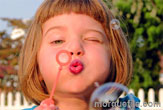Bubbles Behaving Badly

Blowing bubbles isn’t just for kids. The bizarre behavior of these whimsical spheres is helping scientists understand the physics of fluids, which govern everything from the bubbles in carbonated beverages to the venting of gas from deep oceanic fissures.
By using high-speed video, scientists from the University of Chicago filmed air being pumped through a nozzle submerged in water. The images, taken at 130,000 frames per second, revealed air bubbles breaking free from the nozzle in sharp jerks instead of pinching off gradually. And the shape of the pinched point was affected by the slightest change to the nozzle. [Video]
This bubble morphing should be taken into consideration for any process that relies on bubbles, the scientists said.
In a pinch
Until 2003, scientists believed all fluids, including air, broke apart in much the same way regardless of whether the fluid was exiting a small or large nozzle, or even how quickly it exited. It was thought that, like water dripping from a faucet, drops and bubbles form circular shapes before pinching off like an upside down teardrop, and dropping into the sink.
Like a blown-up balloon, an air bubble consists of a stretchy skin shaped into a sphere enclosing a pocket of air. By taking on a circular shape, an air bubble encloses the maximum amount of air in the minimum amount of space—something many city residents can understand when trying to cram stuff into a tiny studio. The force driving this smooth shape: surface tension, a property that causes the surface of a liquid to act as an elastic skin. In this case, a pocket of air is sealed inside a stretchy skin of water.
“Surface tension is exceptionally good at rounding things out,” co-researcher Nathan Keim told LiveScience.
Sign up for the Live Science daily newsletter now
Get the world’s most fascinating discoveries delivered straight to your inbox.
Kitchen lab
In the first experiment, the scientists used a pump to slowly push air through a perfectly cylindrical nozzle that was submerged in water. As expected, each bubble formed a sphere before popping off the nozzle.
Next, they upped the speed of the streaming air, and the bubbles got wacky. Resembling a ribbon, the exiting bubbles tore off the nozzle in sharp jerks.
"It would be almost like plastic or paper, something that you can tear. When you pulled it apart, it wouldn't snap all at once. It would tear across its breadth," Keim said. Plus, the bubbles took on the shape of lopsided spheres.
Warped bubbles
The scientists suspect the shape-change occurs when a small deformity in the nozzle imprints itself on the exiting air bubble. In the first experiment, "that wasn't an issue at all because the bubble managed to just straighten itself out. The problem with this one is that it doesn't straighten itself out," said co-researcher Wendy Zhang, a physicist at the University of Chicago. Even a small tenth of a degree tilt of the nozzle affected the bubble’s shape. "We had no idea that air bubbles were sensitive to such slight tilt," Keim said. If you were hanging a picture, a tenth of a degree off would be a great job, he added.
Blowing bubbles while underwater is a “perfect” example of this imperfect nozzle effect. “You mouth is not cylindrical and it’s definitely not level,” he said. Figuring out these bubble shapes would be a nightmare for physicists, Keim added.
Could this tabletop experiment lead to methods for concocting star-shaped and other exotic bubbles? That’s one of the questions the scientists are asking. But before getting carried away, they will take an even closer look at the abnormal bubbles to better understand the mechanism driving the lopsidedness.
- See the Bubble Video
- The New Mystery of Water
- Champagne Bubble Mystery Solved
- Most Popular Myths in Science
Jeanna Bryner is managing editor of Scientific American. Previously she was editor in chief of Live Science and, prior to that, an editor at Scholastic's Science World magazine. Bryner has an English degree from Salisbury University, a master's degree in biogeochemistry and environmental sciences from the University of Maryland and a graduate science journalism degree from New York University. She has worked as a biologist in Florida, where she monitored wetlands and did field surveys for endangered species, including the gorgeous Florida Scrub Jay. She also received an ocean sciences journalism fellowship from the Woods Hole Oceanographic Institution. She is a firm believer that science is for everyone and that just about everything can be viewed through the lens of science.










